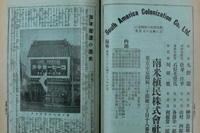Emigration to Brazil and coffee
"What does a coffee tree look like? Because I had never seen a painting or photograph of it , often imagined…" Teijiro Suzuki met Ryo Mizuno aboard a ship bound for Chile in late 1905. Suzuki, who sympathized with Mizuno's emigration project, began to work on a coffee farm in the following year before the arrival of the ship Kasato-maru, proving for himself that Japanese emigrants had aptitude for the work on coffee plantations, and came to be known as "the model of a Japanese emigrant". Needless to say, working as a colono (contract laborer) on a coffee plantation and returning home wealthy was the common dream that all "clean and orderly" emigrants had. For them Brazil was the country in which money-bearing trees they had never seen grew thick.
It is said that coffee was brought to Japan by Dutch people after Sakoku. It, however, took so much time for coffee to be popular. The import of coffee began in earnest in 1866 when the kaizei-yakusho (revised agreement on trade attached to the Ansei Five Power Treaties) reduced import tariffs drastically. But the amount of coffee imported each year between 1877 in which it began to appear in customs clearance records for the first time and 1912, did not exceed 100 tons. Compared to the average price for 15kg of rice at 55 sen 5 rin (0.555 yen), the cost for 1kg of imported coffee was 32 sen 6 rin (0.326 yen), equal to the price for 75 kg of rice in 1877. These data show that cofee was a luxury good.
There was a record relating to coffee cultivation and emigration that in the early 17th century, many Japanese worked on coffee plantations of the Dutch East India Company (in Java), and among emigrants to Hawaii and Mexico from the Meiji Era onwards, there were not a few emigrants who succeeded in life, rising from a laborer on a coffee plantation. The year 1908, in which the 1st set of emigrants to Brazil arrived in the country, the São Paulo State Government concluded an agreement with Ryo Mizuno that the Government should provide him with 7,125 bags 70kg of coffee gratis for the next three years in order to expand coffee sales and that he would open coffee shops in Tokyo, Yokohama and other various cities across Japan.(「伯国産珈琲本邦ニ於ケル販路拡張契約ニ関スル件」(source:Website of the Japan Center for Asian Historical Records)). Mizuno could not find any way how to sell off such a huge amount of Brazilian coffee, 7 times the total annual import amount of coffee at the time. To begin with, he could not get a permission to import the coffee from the Japanese Government. At this moment, Shigenobu Okuma helped him both politically and economically. Okuma said, "The coffee produced by Japanese emigrants in Brazil should be treated as a quasi domestic product. Because coffee obtained through the efforts of Mizuno increase consumption of sugar, this business will bring happiness to Japan in the future". Interesting is tha fact that Okuma, who participated in various emigration projects at the time, also played a major role in the popularization of Brazilian coffee in Japan.
In February of 1910, Mizuno founded a limited partnership called "Café Paulista" (Paulista means a person from the state of São Paulo). In October 1913, the partnership was incorporated with a capital increase. Its main coffee shop was located in Ginza and branch shops were opened in major cities all over the country. The influences that emigration to Brazil and "Café Paulista" begun by Mizuno had on coffee industry in Japan were immeasurable. The trade mark logo of the company at the time of its founding which imitated the coat of arms of São Paulo State, still proudly adorns the door of the "Café Paulista" shop in Ginza today.








